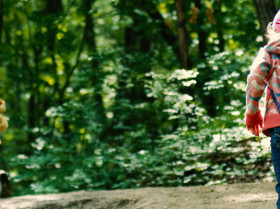The physically literacy movement is moving fast and furious, and this is a good thing. For those of you newer to the conversation, a quick review: Physical literacy is the “competence and confidence to be physically active in a wide variety of environments in order to benefit your health, others’ and the environment”. It’s a journey, not a destination. Physical literacy is individualized - so it’s an inclusive term, one that accounts for different strengths and different challenges.
Why is it such a good thing that the movement is strong?
Society is in desperate need to have normalized behaviors, infrastructure and policy better align with physical literacy than they currently do. Big time. To improve normalized behaviors, infrastructure, and policy, it’s going to take physical education, sport, recreation, early childhood, core curriculum, health promoting schools, PARENT(s)/GUARDIAN(s), etc. In other words, the movement must be collaborative. Yet, understanding that the K-12 years are certainly formative, and that PE is a consistent (hopefully) throughout these years, one can conclude that quality PE plays a very key role in developing physical literacy in students.
This is why:
- Students can’t just develop physical competency on land, or on ice, or in water, or on snow if they want to be physically literate. They must develop skill competency, and understand how to apply a wide range of skills in a diverse environments (snow, ice, water, land), to benefit their health. And, while 50% of my work is in sport - and, love sport (I was a college athlete), sport won’t cut it (physical literacy development) alone. You see, playing college soccer didn’t prepare me to compete in triathlons as an almost-40-year-old-mom-of-two. Nope. Swimming skills were formed through swimming lessons, swimming in the ocean and lakes near my house, etc. So, while many life lessons are very important when purposefully learned within good sport, early specialization in a sport does not develop (nor does it claim to) competence in a variety of environments. Thus, we need quality PE with a balanced curriculum to support students in gaining the skills necessary to develop enough competence to feel confident - and thus, motivated - to be active enough for health gain.
- Current infrastructure and policy is a muck. Or, perhaps a better way to describe current infrastructure and policy is that they are totally inadequate when it pertains to physical literacy. Citizens are far too often met with barriers for physical activity because engineers, planners, politicians - and those who elected them - were not concerned with providing individuals with health-supporting communities. How many bridges have bike paths or run/walk lanes that are separate and safe? How many busy streets lack bike paths, bike lanes, and sidewalks? Can we stop calling kids lazy? Adults have created this mess. We need quality PE so the kids in school grow up with a different lens - a physically literate lens, if you will. It doesn’t just mean that these students grow up to live healthy lives, it means they all grow up deeming healthy lives as important for all. They work to increase current communities to better support physical literacy development. We need them to grow up and build better bridges, roads, and communities.
- Where else, other than in some (minority) of homes will students learn moderation about technology? In quality PE, students must learn to disconnect from the internet and connect with each other to work on skills that have always been important - but are categorized now as 21st century learning skills. These include creativity, communication, collaboration, risk-talking, etc. We have NO idea what the world will look like in 20 years other than kids will be more obese, more sedentary, and more addicted to technology unless we teach/support them - through quality PE, at home, in sport, etc. - to foster physical literacy. The thing is, far too often PE teachers are more excited to purchase a class set of iPads than a class set of bikes. To me, this is insane considering the investment on a class set of bikes is much longer lasting than a class set of iPads. Can’t the classroom teacher order those? I don’t mind tech in schools - not at all. I think it’s imperative. But, we are relentless (as educators) in forcing it on kids without longitudinal data on how it impacts their brain development and (potentially) hinders inter and intra personal skills considering HOW much time kids are in front of a screen. I just encourage us to be reflective, I wonder how different society would be if planners, engineers, etc. paused and reflected on the impact of the way they built communities the last 40 years?
I really have to be clear here. I also appreciate, RT, like, favorite and share amazing posts related to technology that support teachers’ productivity. I have attended wonderful sessions by colleagues on using technology in terms of assessment - and it’s been presented with best practice teaching strategies. All of this belongs. For sure. I just fear that amount of tweets asking “How can I use an iPad in PE?” Some of my favorite folks to follow on Twitter are people who bring a really strong tech perspective and expertise to the community - they are amazing professionals and I’m not just trying to be nice in saying that. I admire them, each of them, greatly and appreciate all I learn from them.
Technology absolutely has an important role to play in schools today and I integrate a lot of tech in my teaching (particularly in assessment for learning practices). I’ve observed (via Twitter) not only incredible collaboration among physical education teachers, but also among students (e.g., I followed a Skype dance-off between middle schools from different states and even different countries - so cool!). Yet, we must remember that kids don’t need Apps to learn and we wouldn’t want them to grow up thinking they do. I feel my own smartphone has made me dumb. I rely on Google maps when I used to bust out the atlas. That’s embarrassing.
It’s not the tech information I have an issue with - not at at all. It’s that WAAAAYYYYY too often I see technology being used as a way to inform folks about 21st century learners and to (not my word) motivate students. In a quality PE program, a “21st century student” does not equate with a tech savvy student, while (again) tech plays a role. Sure, students may love screens - but it’s our job to also teach them how to love nature and want to explore it by kayak, foot, bike, etc. But, how much 5-10 year old tech is sitting in school closets? How many dollars were spent? Is it all necessary? I never have all the answers, but I sure love asking the questions.
Why?
Did you know that Einstein’s work is being reconsidered (as I type) as a way to develop eco-friendly refrigeration and cooling options for society? How ‘cool’ (pun intended) is that? We must support students in thinking critically using creative methods, but not spend too much of our time as educators keeping up with the latest tech in lieu of righting social injustices- of which will most certainly become obsolete. My biggest disappointment with Twitter is that there isn’t enough dialogue in the #physed community around social justice issues (Although @MrBridge204 is really great about this AND tech) Don’t get me wrong, our kids need to become technology literate. This makes sense because those of us active on Twitter are clearly among the most comfortable with technology, perhaps.
I can’t fathom a tech specialist NOT supporting the notion that kids need to learn balance, need to learn how to live healthy lives, and learn why it’s necessary to unplug, too. PE is necessary for physical literacy development, and PE teachers must stay focused in delivering balanced programs with physical literacy as the intent. And, the percentage of kids each year who will not have access to tech because they live in poverty rises. These kids, along with all other kids, must develop skills, understand how to be active for health gain, and how to access community and facilities in order to improve health....just like we did.
My biggest fear is that, without reflection, we may be using technology as a way to “hook” or “bribe” kids. I don’t want us to be lazy. I want us to develop relationships with kids. I want us to teach kids and for them to teach us. I want us to listen to them. Is the tech hindering their social development? Cognitive development? I’m not certain we evolved to be attached to a screen anymore than we evolved to sit in a chair all day.
 Please don’t take #3 as a tech bashing, it’s not. I love the great work that my colleagues share on tech in PE. I love Twitter, Facebook, and other forms of social media. But, when I taught middle school, I was able to purchase heart rate monitors for my class through a tech grant, yet there was no grant for bikes or skate boards. This is despite the fact that perceived exertion (PE) really does work as well as HR monitors - I use perceived exertion in my own training for the Boston Marathon in 2013. That’s right, I chose to purchase a kahuna longboard instead of a HR monitor. :)
Please don’t take #3 as a tech bashing, it’s not. I love the great work that my colleagues share on tech in PE. I love Twitter, Facebook, and other forms of social media. But, when I taught middle school, I was able to purchase heart rate monitors for my class through a tech grant, yet there was no grant for bikes or skate boards. This is despite the fact that perceived exertion (PE) really does work as well as HR monitors - I use perceived exertion in my own training for the Boston Marathon in 2013. That’s right, I chose to purchase a kahuna longboard instead of a HR monitor. :)
I hope it’s now clear why I feel strongly that quality PE is a very key component of developing physical literate community members. Physical activity and sport and free play time all play key roles as well, I just think quality PE is the golden ticket to creating a more health-enhancing and health-providing society.
I gotta run...literally.
Have a healthy and active day!





